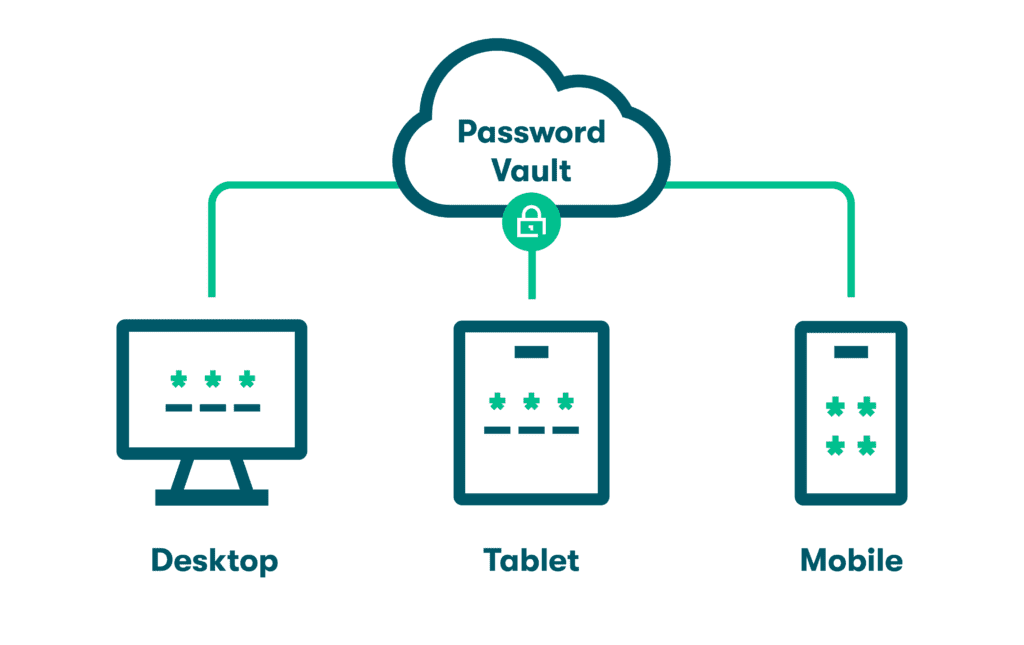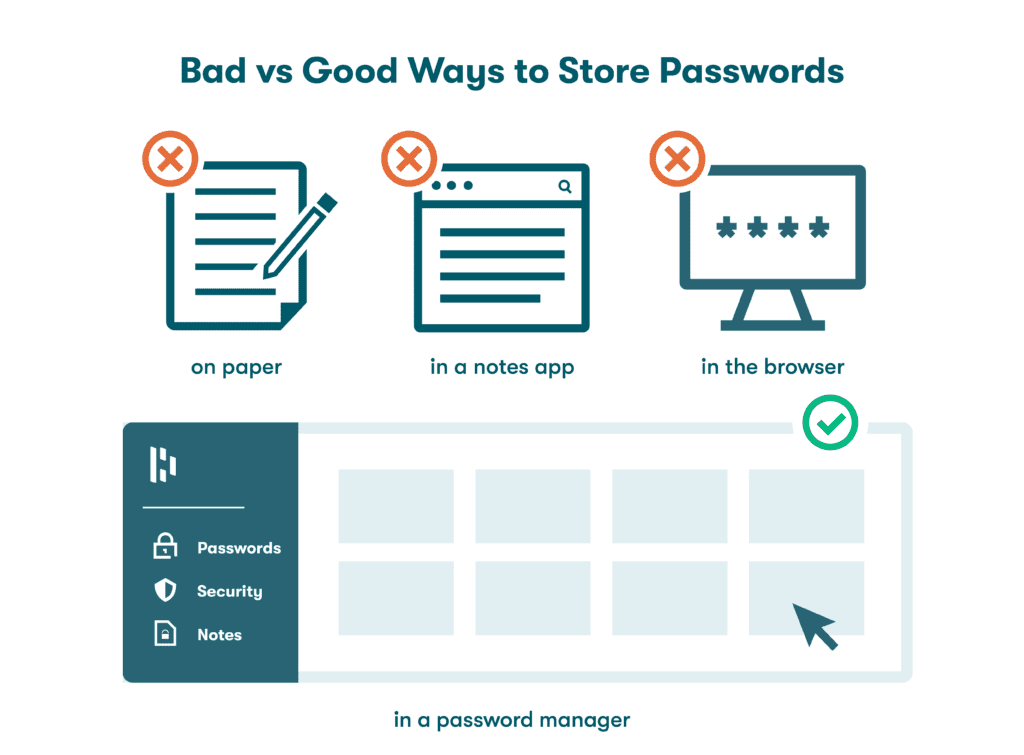Pros and Cons of Google Password Manager
Is using Google password manager safe? Google Chrome’s built-in password manager is a popular option for millions of users, so let’s examine its pros and cons, along with some alternatives.
How does Google password manager work?
With our growing lists of logins and a slew of hacking tactics to watch out for, we all need a password manager to make our online browsing and transactions more secure. Leading browser developers like Google address by providing a built-in password manager. These built-in options:
- Are automatically installed and enabled by default. If you’re using Google Chrome and have created your own Google account, then you’re already set up to use the built-in Google password manager that’s enabled by default. Unless you manually disable this feature, you will continue to see a familiar dialog box asking if you’d like Google to save your credentials each time you log in to an online account.
- Easy to access—for everyone. Is saving passwords in Chrome safe? If you’ve used the Google password manager in the past, you probably know your list of saved passwords is just a few clicks away in the Settings menu. This is true for you, as well as anyone else who gains access to your device.
- Autofill your information. A feature known as autofill, common to password managers, allows you to automatically populate stored usernames and passwords when you return to the same website, thereby eliminating the need to memorize passwords or write them down. This convenient feature can become a liability if your Google account is accessed by a hacker and passwords for private accounts automatically appear. Password managers like Dashlane use more secure autofill methods to protect customer data, such as not autofilling on invisible forms, warning you if you try to autofill a login on a new website, and preventing vault data from being accessed by a website from an autofill webcard.
Want to learn more about using Dashlane Password Manager at home or at work?
Check out our personal password manager plans or get started with a free business trial.
The pros of using browser password managers
Many people who choose to only use Google Chrome or another major browser like the simplicity that comes from a built-in password management option. The pros of using browser password managers include:
- Convenience: There’s nothing to install or set up with browser password managers. Some choose this convenience over the security features of a standalone password manager. Those who have already stored multiple logins in their browser might also prefer to continue using it rather than taking the time to export their password list when upgrading to a standalone option.
- Free: The Google password manager, along with the other built-in browser password managers, is always totally free, and customers may consider this benefit in their choice of password managers. It’s no accident that almost 95% of iOS apps in the Apple Store are still offered for free since many consumers will sacrifice desirable features to avoid a financial commitment—even a minimal one.
The cons of using browser password managers
Is Google password manager safe? All built-in browser password managers lack important security features and benefits. This should be carefully considered when deciding between browser password managers and standalone password managers.
- Limited functionality: The basic features of a browser password manager include password generation, password storage, and autofill. But is that enough? The features included with standalone password managers form a more complete cybersecurity solution. These can include secure password sharing portals, a password health score to monitor your password hygiene, a VPN, single sign-on (SSO), and dark web monitoring to scan the hidden recesses of the internet for your private information. Plus, a standalone password manager syncs across all your devices and accounts outside of Chrome.

- Security vulnerabilities: No Google password manager review would be complete without discussing some known Google Chrome vulnerabilities. Using a browser for password management leaves your credentials exposed if the weaknesses of the browser itself are exploited. In 2022, researchers discovered a vulnerability in the Chrome browser that could have allowed billions of files to be stolen if left unpatched. In addition, Chrome can be opened with just a single click, which can make your sensitive password data a bit too accessible.
How to safely use Google Password Manager
For those who choose this option, taking a few extra security precautions can help offset some of the risks and vulnerabilities.
- Consider not using it: The limited security features and known vulnerabilities make you more susceptible to a cyberattack. The safest course of action is to avoid using browser password managers of any kind and erase any passwords saved in browsers to prevent them from being exposed in the future. Instead, use a standalone password manager. An intuitive standalone password manager makes all your passwords more secure. The best password managers create complex passwords for your accounts, then encrypt and store them safely in the cloud to protect them from hacking and data breaches.
- Use strong passwords: The Google password manager allows you to continue using your previously created passwords, even if they are weak or reused, although it does provide you with a password generator feature. This leaves it up to you to create strong passwords that are harder for hackers to guess and don’t unlock multiple accounts.
- Don’t share your computer: With passwords and saved account information readily accessible through the Chrome Settings menu, sharing your computer or device with others also means sharing your list of logins. The potential for compromised privacy makes it wise to avoid sharing your computer, even with close friends and relatives, if you’re using the Google password manager.
- Don’t share your passwords: Sharing passwords with friends and family members is a common practice, especially for things like online retail accounts and streaming services. Password sharing increases your level of exposure if those you share with are impacted by cybercrime. Unlike browser password managers, the best standalone password managers include secure, encrypted password sharing portals that allow you to transfer logins safely. For example, the Dashlane sharing portal can be used to share Secure Notes and passwords with other Dashlane users.
- Secure your Google account: How secure is Google password manager? This depends in part on how secure your Google account is in general since all the apps you use through the account are connected. You can secure your Google account and optimize Google password manager security by creating a strong and unique Google account password, setting up 2-factor authentication (2FA), ensuring your recovery email address is current, and keeping tabs on any third-party apps that have permission to access your Google account.
Why standalone password managers are more secure

With so many advanced security and privacy features to protect you from hacking and keep your data safe, the best standalone password managers are simply more secure than the Google Chrome password manager. A good standalone password manager:
- Comes with protected storage: High-quality standalone password managers encrypt your passwords on your device or computer before transporting them to a protected cloud server for storage. Dashlane utilizes patented zero-knowledge architecture to ensure no one (not even Dashlane) can access your unencrypted information. Using your Master Password or secure SSO are the only ways your stored data can be unlocked.
- Reduces password reuse: With the average person now juggling over 240 online accounts, password reuse is an increasingly common habit. This practice can make us more vulnerable to hacking tactics like credential stuffing since multiple accounts can be hit. Monitoring features provided with the best standalone password managers, like the Dashlane Password Health score, discourage password reuse by providing you with an up-to-date list of your weak, compromised, and reused passwords.
- Works with all browsers: Like other built-in browser password managers, Google’s only works while you’re using the Chrome browser. Saved passwords become inaccessible the moment you exit Chrome. The Dashlane browser extension works with all major browsers and operating systems, including Chrome, Firefox, Microsoft Edge, Linux, and Chromebook, so your password generation, storage, and autofill features stay with you as you navigate across platforms and devices.
- Additional features: Other valuable features you won’t always find in browser password managers include 2FA, SSO, safe password sharing, automatic password synchronization across devices, dark web monitoring, and a VPN. A VPN protects you from hacking and data intercepts while using public WiFi networks by encrypting all data going into or out of your device and routing it through a secure portal. A VPN also masks your IP address to make browsing more private.
Dashlane optimizes password security without compromising convenience by combining the best available standalone password manager security features with the benefits of a Password Health score, secure password sharing portal, and customizable password generation and autofill settings. Since Dashlane works with any major browser, these advantages stay with you around the clock.
While cybercriminals might be growing savvier, so are the tools that protect our online assets. By following six essential cybersecurity rules, you can clean up your digital footprint and keep your personal data safe.
References
- PC Magazine, “How to Master GooglePassword Manager,” April 2022.
- Dashlane, “What Is Encryption?” March 2019.
- Dashlane, “6 Things a Safe Username Should Always Do,” February 2023.
- Statista, “Distribution of free and paid iOS apps in the Apple App Store as of March 2023,” March 2023.
- Dashlane, “Understanding your Dashlane Password Health Score,” October 2020.
- Dashlane, “How to Shine a Light on the Dark Web,” June 2022.
- Computer Weekly, “Chrome vulnerability could have led to widespread data theft,” January 2023.
- Dashlane, “How to Erase Saved BrowserPasswords: Step-by-Step Guide,” November 2022.
- Dashlane, “How Strong Is Your Password & Should You Change It?” August 2022.
- Dashlane, “Share your saved items in Dashlane,” 2023.
- Dashlane, “4 Steps to Secure YourGoogle and Gmail Accounts,” November 2021.
- Dashlane, “Build the Case for a Password Manager in 8 Steps,” 2023.
- Dashlane, “A Deep Dive into Dashlane's Zero-Knowledge Security,” June 2022.
- Dashlane, “A look at Password Health Scores around the world in 2022,” 2022.
- Dashlane, “The Best Browser Extensions for Digital Privacy,” October 2020.
- Dashlane, “Why Do You Need a VPN? Don’t Miss These 3 Key Benefits,” August 2020.
- Dashlane, “Do You Have These 6 Cybersecurity Basics Down?” June 2022.
- Dashlane, “How to Export Google Chrome Passwords to a CSV,” April 2023.
- Dashlane, “A Guide to Protecting Passwords from Hackers,” February 2023.
- PCMag, “How to Master Google Password Manager,” April 2022.
- Dashlane, “Putting Security First: How Dashlane Protects Your Data,” January 2023.
- Dashlane, “7 Dangers of Sharing Passwords Without a Password Manager,” March 2023.
- Dashlane, “A Beginner’s Guide to Two-Factor Authentication,” August 2022.
- CrowdStrike, “Credential Stuffing,” March 2022.
Sign up to receive news and updates about Dashlane
